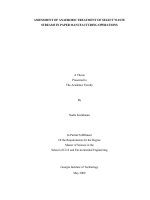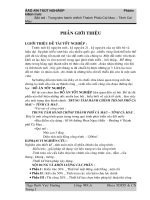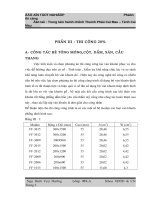Waste heat recovery pot
Bạn đang xem bản rút gọn của tài liệu. Xem và tải ngay bản đầy đủ của tài liệu tại đây (567.25 KB, 32 trang )
1
Training Session on Energy
Training Session on Energy
Equipment
Equipment
Waste Heat Recovery
Waste Heat Recovery
Presentation from the
“Energy Efficiency Guide for Industry in Asia”
www.energyefficiencyasia.org
T
h
e
r
m
a
l
E
q
u
i
p
m
e
n
t
/
W
a
s
t
e
h
e
a
t
r
e
c
o
v
e
r
y
©
©
UNEP 2006
UNEP 2006
2
Training Agenda: Waste
Training Agenda: Waste
Introduction
Type of waste heat recovery
Assessment of waste heat recovery
T
h
e
r
m
a
l
E
q
u
i
p
m
e
n
t
/
W
a
s
t
e
h
e
a
t
r
e
c
o
v
e
r
y
©
©
UNEP 2006
UNEP 2006
3
©
©
UNEP 2006
UNEP 2006
Introduction
Introduction
•
“Dumped” heat that can still be
reused
•
“Value” (quality) more important than
quantity
•
Waste heat recovery saves fuel
What is Waste Heat?
T
h
e
r
m
a
l
E
q
u
i
p
m
e
n
t
/
W
a
s
t
e
h
e
a
t
r
e
c
o
v
e
r
y
4
©
©
UNEP 2006
UNEP 2006
Introduction
Introduction
Source and Quality
T
h
e
r
m
a
l
E
q
u
i
p
m
e
n
t
/
W
a
s
t
e
h
e
a
t
r
e
c
o
v
e
r
y
Table: Waste heat source and quality
S. No Source of Waste Heat Quality of Waste Heat
1 Heat in flue gases The higher the temperature, the greater the
potential value for heat recovery
2 Heat in vapour streams As above but when condensed, latent heat
also recoverable
3 Convective & radiant heat lost
from exterior of equipment
Low grade – if collected may be used for
space heating or air preheats
4 Heat losses in cooling water Low grade – useful gains if heat is exchanged
with incoming fresh water
5 Heat losses in providing
chilled water or in the
disposal of chilled water
1.High grade if it can be utilized to reduce
demand for refrigeration
2.Low grade if refrigeration unit used as a
form of Heat pump
6 Heat stored in products
leaving the process
Quality depends upon temperature
7 Heat in gaseous & liquid
effluents leaving process
Poor if heavily contaminated & thus requiring
alloy heat exchanger
5
©
©
UNEP 2006
UNEP 2006
Introduction
Introduction
High Temperature Heat Recovery
T
h
e
r
m
a
l
E
q
u
i
p
m
e
n
t
/
W
a
s
t
e
h
e
a
t
r
e
c
o
v
e
r
y
Table: Typical waste heat temperature at high temperature
range from various sources
Types of Devices Temperature (
0
C)
Nickel refining furnace 1370 – 1650
Aluminium refining furnace 650 –760
Zinc refining furnace 760 – 1100
Copper refining furnace 760 – 815
Steel heating furnace 925 – 1050
Copper reverberatory furnace 900 – 1100
Open hearth furnace 650 – 700
Cement kiln (Dry process) 620 – 730
Glass melting furnace 1000 – 1550
Hydrogen plants 650 – 1000
Solid waste incinerators 650 – 1000
Fume incinerators 650 – 1450
6
©
©
UNEP 2006
UNEP 2006
Introduction
Introduction
Medium Temperature Heat
Recovery
T
h
e
r
m
a
l
E
q
u
i
p
m
e
n
t
/
W
a
s
t
e
h
e
a
t
r
e
c
o
v
e
r
y
Table: Typical waste heat temperature at medium temperature range
from various sources
Types of Devices Temperature (
0
C)
Steam boiler exhaust 230 – 480
Gas turbine exhaust 370 – 540
Reciprocating engine exhaust 315 – 600
Reciprocating engine exhaust (turbo
charged)
230 – 370
Heat treatment furnace 425 – 650
Drying & baking ovens 230 – 600
Catalytic crackers 425 – 650
Annealing furnace cooling systems 425 – 650
7
©
©
UNEP 2006
UNEP 2006
Introduction
Introduction
Low Temperature Heat Recovery
T
h
e
r
m
a
l
E
q
u
i
p
m
e
n
t
/
W
a
s
t
e
h
e
a
t
r
e
c
o
v
e
r
y
Source Temperature
0
C
Process steam condensate 55-88
Cooling water from: Furnace doors 32-55
Bearings 32-88
Welding machines 32-88
Injection molding machines 32-88
Annealing furnaces 66-230
Forming dies 27-88
Air compressors 27-50
Pumps 27-88
Internal combustion engines 66-120
Air conditioning and refrigeration condensers 32–43
Liquid still condensers 32-88
Drying, baking and curing ovens 93-230
Hot processed liquids 32-232
Hot processed solids 93-232
Table: Typical waste heat temperature at low
temperature range from various sources
8
©
©
UNEP 2006
UNEP 2006
Training Agenda: Waste
Training Agenda: Waste
Introduction
Type of waste heat recovery
Performance evaluation
T
h
e
r
m
a
l
E
q
u
i
p
m
e
n
t
/
W
a
s
t
e
h
e
a
t
r
e
c
o
v
e
r
y
9
©
©
UNEP 2006
UNEP 2006
Type of Waste Heat Recovery
Type of Waste Heat Recovery
Commercial Waste Heat Recovery
T
h
e
r
m
a
l
E
q
u
i
p
m
e
n
t
/
W
a
s
t
e
h
e
a
t
r
e
c
o
v
e
r
y
Recuperators
•
Heat exchange
between flue gases and
the air through
metallic/ceramic walls
•
Ducts/tubes carry
combustion air for
preheating
•
Waste heat stream on
other side
Inlet air from
atmosphere
Outside
ducting
Tune plate
Preheated
air
Centre tube plate
Exhaust gas
from process
Figure 1 : Waste heat recovery
using recuperator, Source: SEAV
10
©
©
UNEP 2006
UNEP 2006
Type of Waste Heat Recovery
Type of Waste Heat Recovery
Commercial Waste
Heat Recovery
T
h
e
r
m
a
l
E
q
u
i
p
m
e
n
t
/
W
a
s
t
e
h
e
a
t
r
e
c
o
v
e
r
y
Metallic radiation
recuperators
Figure 2. Metallic Radiation
Recuperator (Hardtech Group)
•
Simplest recuperator
•
Two metal tubes
•
Less fuel is burned per
furnace load
•
Heat transfer mosly by
radiation
11
©
©
UNEP 2006
UNEP 2006
Type of Waste Heat Recovery
Type of Waste Heat Recovery
Commercial Waste Heat Recovery
T
h
e
r
m
a
l
E
q
u
i
p
m
e
n
t
/
W
a
s
t
e
h
e
a
t
r
e
c
o
v
e
r
y
Convective
recuperators
Figure 3. Convective
Recuperator
(Reay, D.A., 1996)
•
Hot gas through
parallel small diameter
tubes
•
Tubes can be baffled
to allow gas to pass
over them again
•
Baffling increases heat
exchange but more
expensive exchanger
is needed
12
©
©
UNEP 2006
UNEP 2006
Type of Waste Heat Recovery
Type of Waste Heat Recovery
Commercial Waste Heat Recovery
T
h
e
r
m
a
l
E
q
u
i
p
m
e
n
t
/
W
a
s
t
e
h
e
a
t
r
e
c
o
v
e
r
y
Radiation/convective
hybrid recuperators
Figure 4. Hybrid Recuperator
(Reay, D.A., 1996)
•
Combinations of
radiation & convection
•
More effective heat
transfer
•
More expensive but less
bulky than simple
metallic radiation
recuperators
13
©
©
UNEP 2006
UNEP 2006
Type of Waste Heat Recovery
Type of Waste Heat Recovery
Commercial Waste Heat Recovery
T
h
e
r
m
a
l
E
q
u
i
p
m
e
n
t
/
W
a
s
t
e
h
e
a
t
r
e
c
o
v
e
r
y
Ceramic recuperators
•
Less temperature limitations:
•
Operation on gas side up to 1550 ◦C
•
Operation on preheated air side to 815 ◦C
•
New designs
•
Last two years
•
Air preheat temperatures <700◦ C
•
Lower leakage rates
14
©
©
UNEP 2006
UNEP 2006
Type of Waste Heat Recovery
Type of Waste Heat Recovery
Regenerator
T
h
e
r
m
a
l
E
q
u
i
p
m
e
n
t
/
W
a
s
t
e
h
e
a
t
r
e
c
o
v
e
r
y
Figure 5. Regenerator
(Department of Coal, India, 1985)
•
Large capacities
•
Glass and steel melting
furnaces
•
Time between the
reversals important to
reduce costs
•
Heat transfer in old
regenerators reduced by
•
Dust & slagging on
surfaces
•
heat losses from the
walls
15
©
©
UNEP 2006
UNEP 2006
Type of Waste Heat Recovery
Type of Waste Heat Recovery
Heat Wheels
T
h
e
r
m
a
l
E
q
u
i
p
m
e
n
t
/
W
a
s
t
e
h
e
a
t
r
e
c
o
v
e
r
y
Figure 6. Heat Wheel
(SADC, 1999)
•
Porous disk rotating
between two side-by-
side ducts
•
Low to medium
temperature waste
heat recovery
systems
•
Heat transfer
efficiency up to 85 %
16
©
©
UNEP 2006
UNEP 2006
Type of Waste Heat Recovery
Type of Waste Heat Recovery
Heat Pipe
T
h
e
r
m
a
l
E
q
u
i
p
m
e
n
t
/
W
a
s
t
e
h
e
a
t
r
e
c
o
v
e
r
y
Figure 7. Heat Pipe
(SADC, 1999)
•
Transfer up to 100
times more thermal
energy than copper
•
Three elements:
- sealed container
- capillary wick
structure -
working fluid
•
Works with
evaporation and
condensation
17
©
©
UNEP 2006
UNEP 2006
Type of Waste Heat Recovery
Type of Waste Heat Recovery
Heat Pipe
T
h
e
r
m
a
l
E
q
u
i
p
m
e
n
t
/
W
a
s
t
e
h
e
a
t
r
e
c
o
v
e
r
y
Performance and advantage
•
Lightweight and compact
•
No need for mechanical maintenance, input
power, cooling water and lubrication systems
•
Lowers the fan horsepower requirement and
increases the overall thermal efficiency of the
system
•
Can operate at 315 ◦C with 60% to 80% heat
recovery
18
©
©
UNEP 2006
UNEP 2006
Type of Waste Heat Recovery
Type of Waste Heat Recovery
Heat Pipe
T
h
e
r
m
a
l
E
q
u
i
p
m
e
n
t
/
W
a
s
t
e
h
e
a
t
r
e
c
o
v
e
r
y
Typical application
•
Process to space heating
-
Transfers thermal energy from process
exhaust for building heating
•
Process to process
-
Transfers recovered waste thermal energy
from the process to the incoming process air
•
HVAC applications
-
Cooling and heating by recovering thermal
energy
19
©
©
UNEP 2006
UNEP 2006
Type of Waste Heat Recovery
Type of Waste Heat Recovery
Economizer
T
h
e
r
m
a
l
E
q
u
i
p
m
e
n
t
/
W
a
s
t
e
h
e
a
t
r
e
c
o
v
e
r
y
Figure 8. Economizer
(Bureau of Energy Efficiency,
2004)
•
Utilize the flue gas heat for pre-heating the boiler
feed water
•
1% fuel savings if
•
60 ◦C rise of feed
water
•
200 ◦C rise in
combustion air temp
20
©
©
UNEP 2006
UNEP 2006
Type of Waste Heat Recovery
Type of Waste Heat Recovery
Economizer
T
h
e
r
m
a
l
E
q
u
i
p
m
e
n
t
/
W
a
s
t
e
h
e
a
t
r
e
c
o
v
e
r
y
Shell and tube heat exchanger
•
Used when the medium containing waste heat is a
liquid or a vapor that heats another liquid
Figure 9. Shell & Tube Heat Exchanger
(King Fahad University of Petroleum & Minerals,
2003)
•
Shell contains
the tube bundle,
and usually
internal baffles
to direct the
fluid
•
Vapor
contained within
the shell
21
©
©
UNEP 2006
UNEP 2006
Type of Waste Heat Recovery
Type of Waste Heat Recovery
Plate Heat Exchanger
T
h
e
r
m
a
l
E
q
u
i
p
m
e
n
t
/
W
a
s
t
e
h
e
a
t
r
e
c
o
v
e
r
y
Figure 10. Plate Heat Exchanger
(Canada Agriculture and Agri-Food)
•
Parallel plates forming a thin flow pass
•
Avoids high cost of heat exchange surfaces
•
Corrugated
plates to
improve heat
transfer
•
When directions
of hot and cold
fluids are
opposite, the
arrangement is
counter current
22
©
©
UNEP 2006
UNEP 2006
Type of Waste Heat Recovery
Type of Waste Heat Recovery
Plate Heat Exchanger
T
h
e
r
m
a
l
E
q
u
i
p
m
e
n
t
/
W
a
s
t
e
h
e
a
t
r
e
c
o
v
e
r
y
Run around coil exchanger
Figure 11. Run Around Coil Exchanger
(SADC , 1999)
•
Heat transfer
from hot to
colder fluid via
heat transfer
fluid
•
One coil in hot
stream
•
One coil in cold
stream
23
©
©
UNEP 2006
UNEP 2006
Type of Waste Heat Recovery
Type of Waste Heat Recovery
Plate Heat Exchanger
T
h
e
r
m
a
l
E
q
u
i
p
m
e
n
t
/
W
a
s
t
e
h
e
a
t
r
e
c
o
v
e
r
y
Waste heat boiler
Figure 12. Two-Pass Water Tube Waste
Heat Recovery Boiler
(Canada Agriculture and Agri-Food)
•
Water tube boiler: hot
exhaust gases pass
over parallel tubes
with water
•
Capacities: 25 m3 to
30,000 m3 /min of
exhaust gas
24
©
©
UNEP 2006
UNEP 2006
Type of Waste Heat Recovery
Type of Waste Heat Recovery
Heat Pump
T
h
e
r
m
a
l
E
q
u
i
p
m
e
n
t
/
W
a
s
t
e
h
e
a
t
r
e
c
o
v
e
r
y
Figure 13. Heat Pump Arrangement
(SADC, 1999)
The vapour
compression cycle
25
©
©
UNEP 2006
UNEP 2006
Type of Waste Heat Recovery
Type of Waste Heat Recovery
Heat Pump
T
h
e
r
m
a
l
E
q
u
i
p
m
e
n
t
/
W
a
s
t
e
h
e
a
t
r
e
c
o
v
e
r
y
Developed as a space heating system
Can upgrade heat >2X the energy
consumed by the device
Most promising when heating and cooling
capabilities are combined









